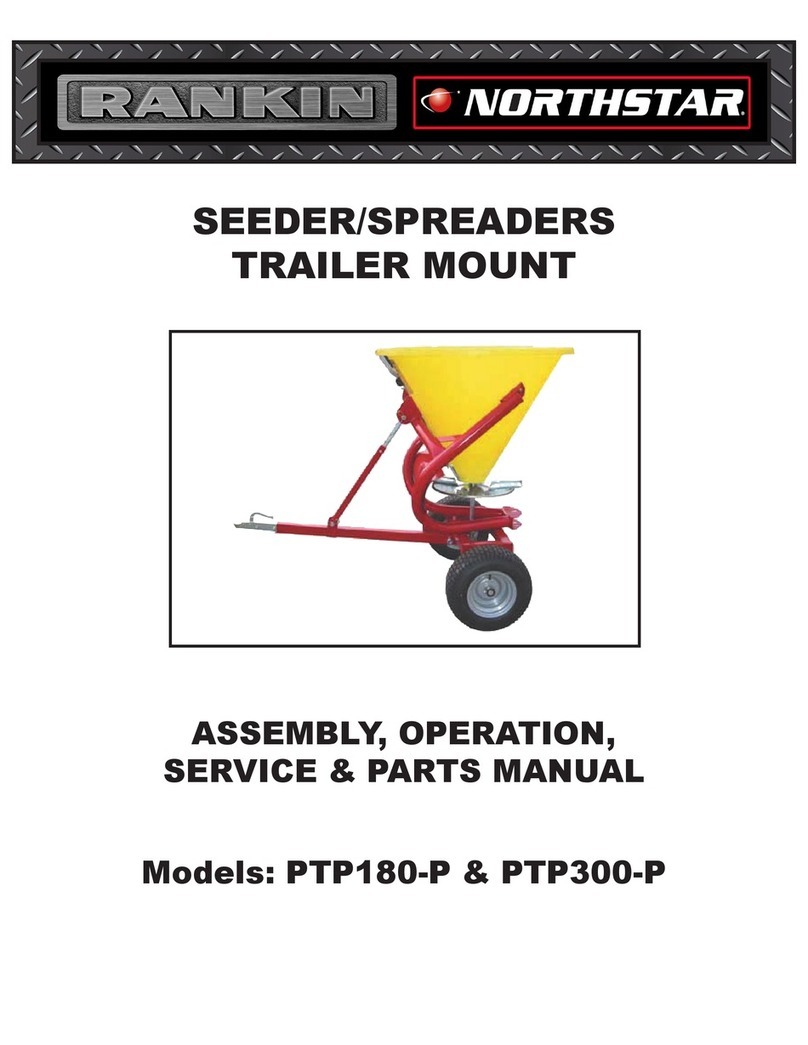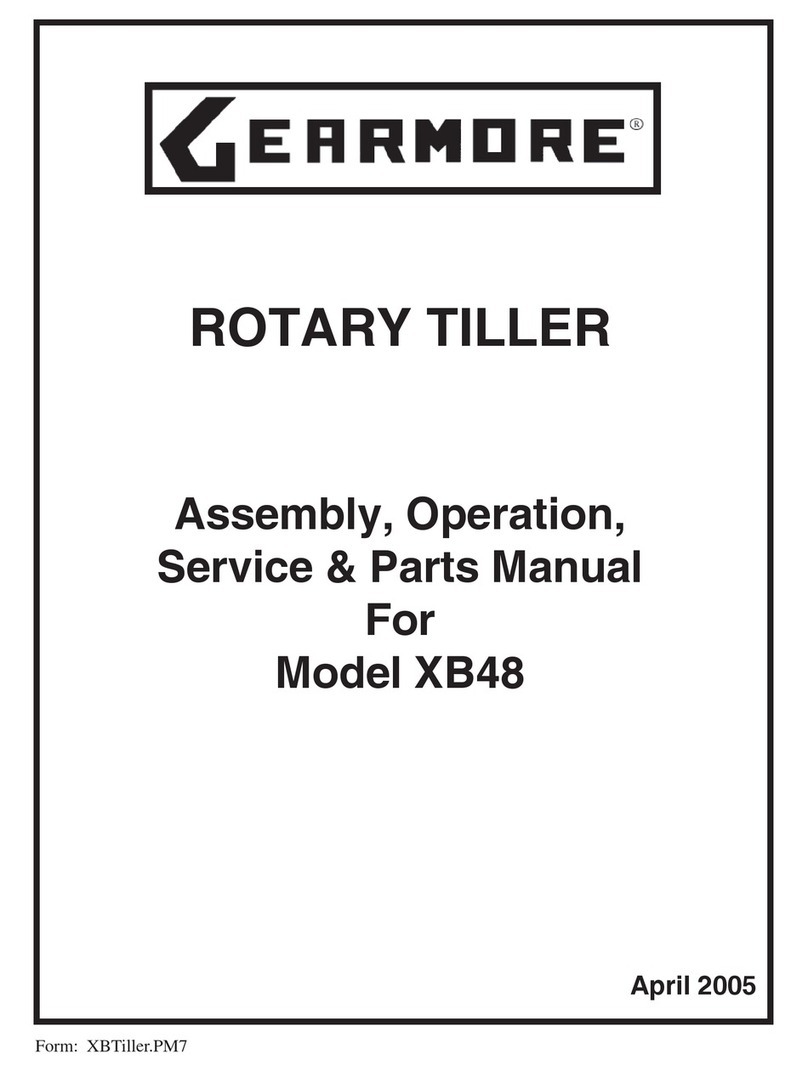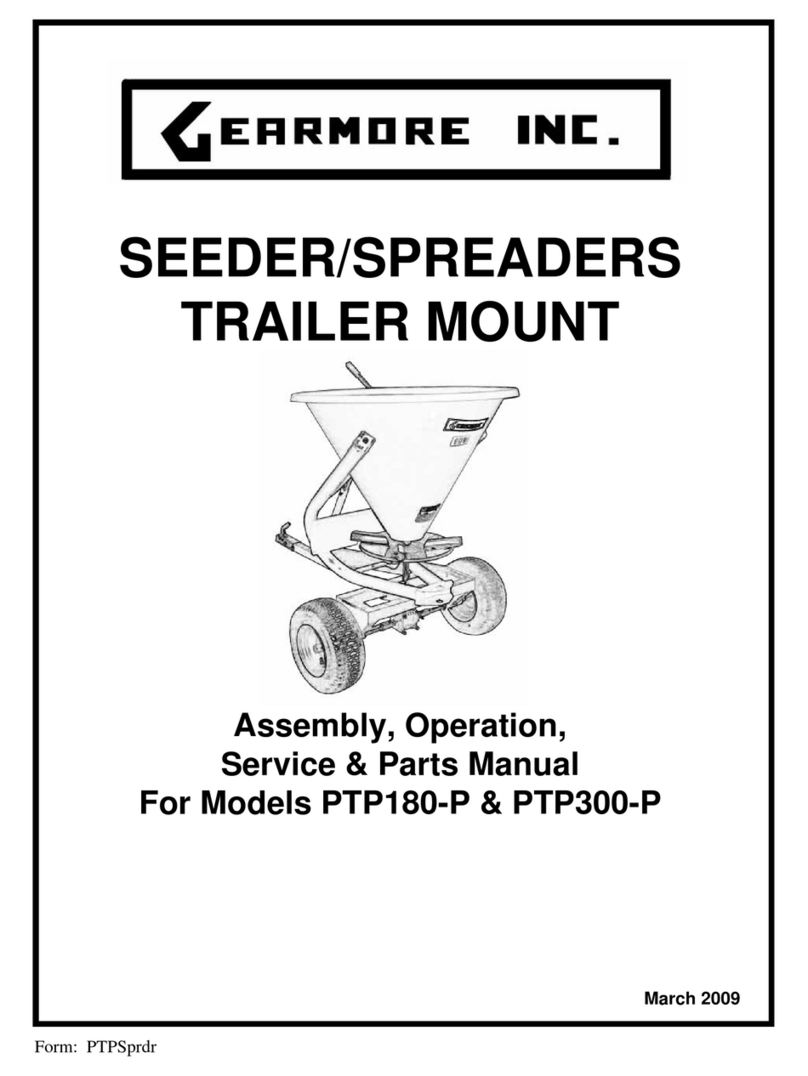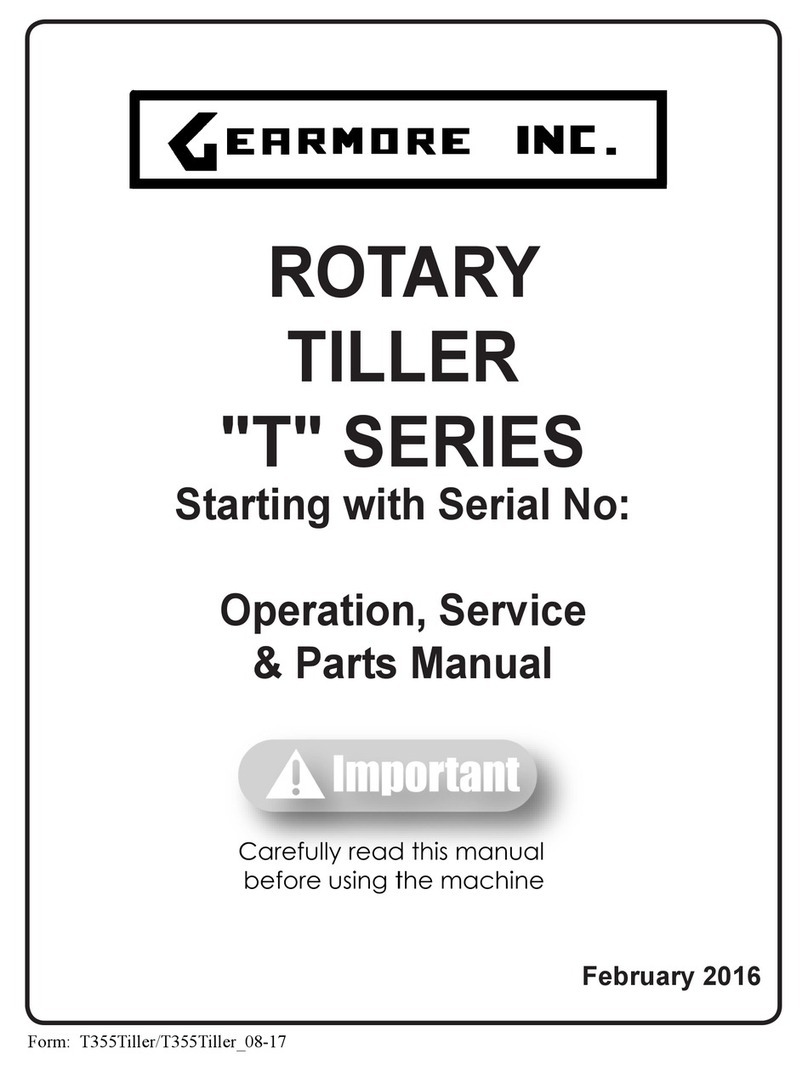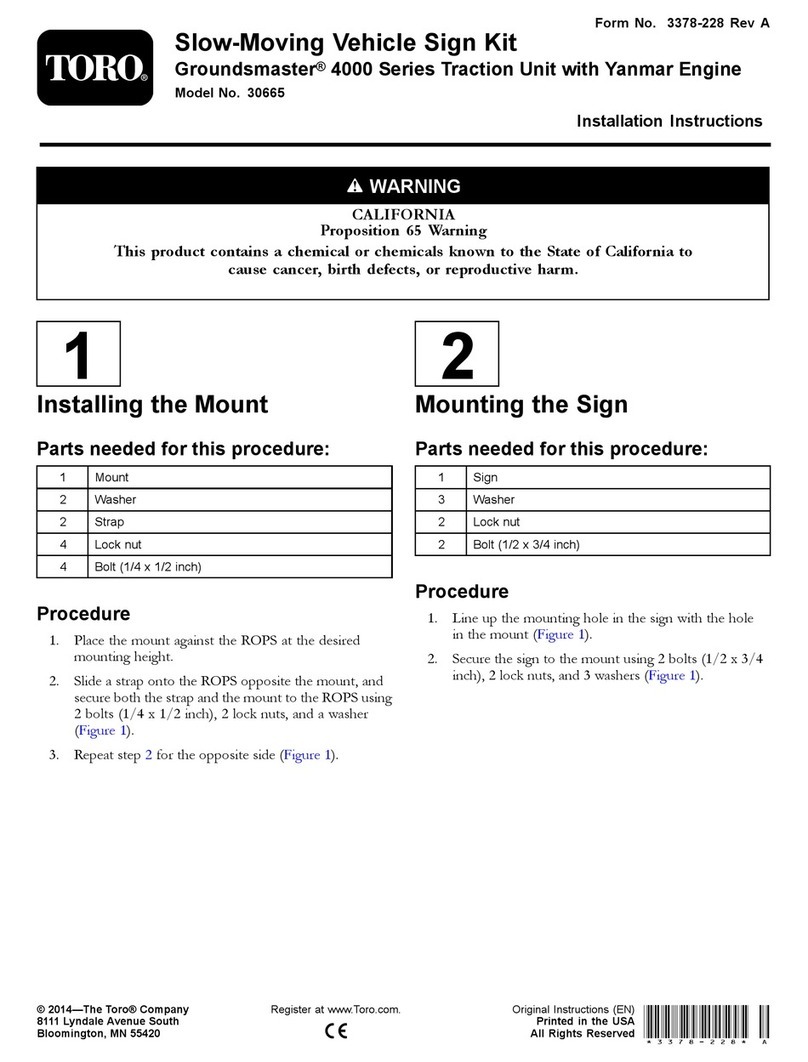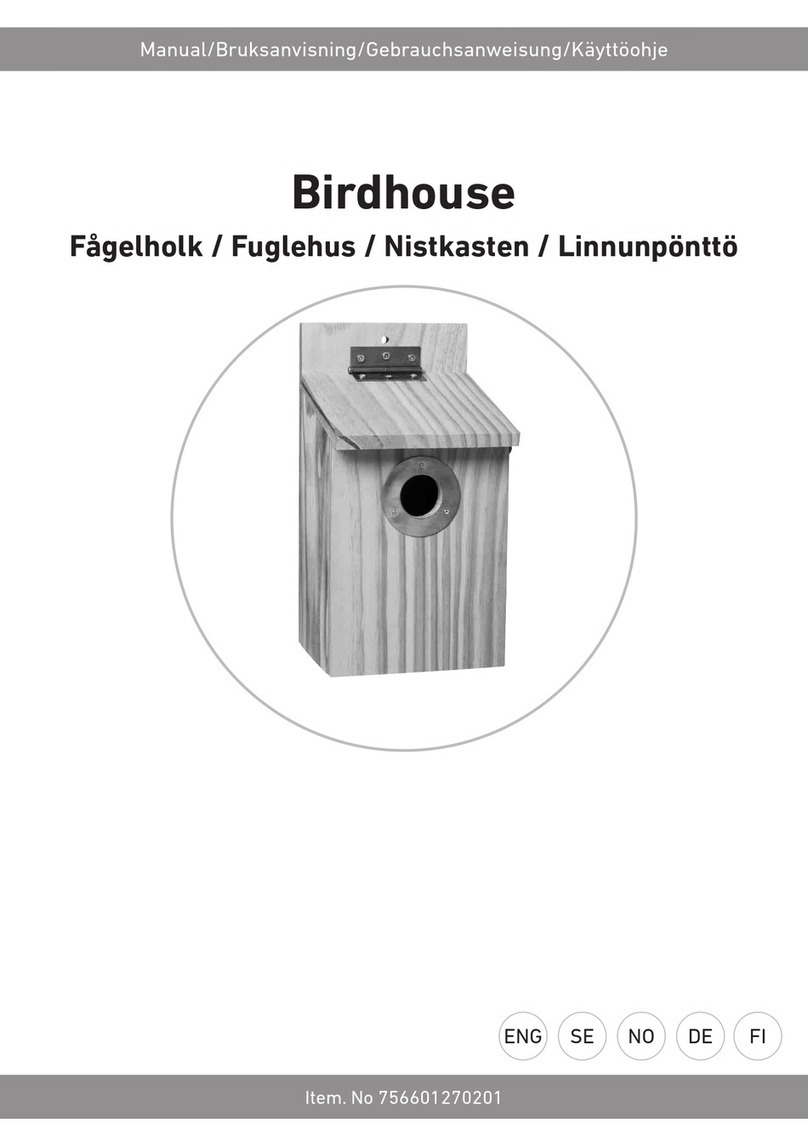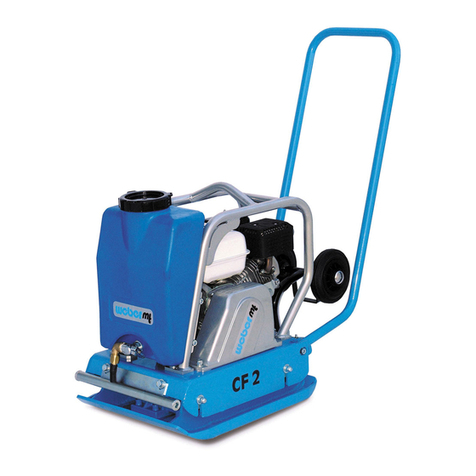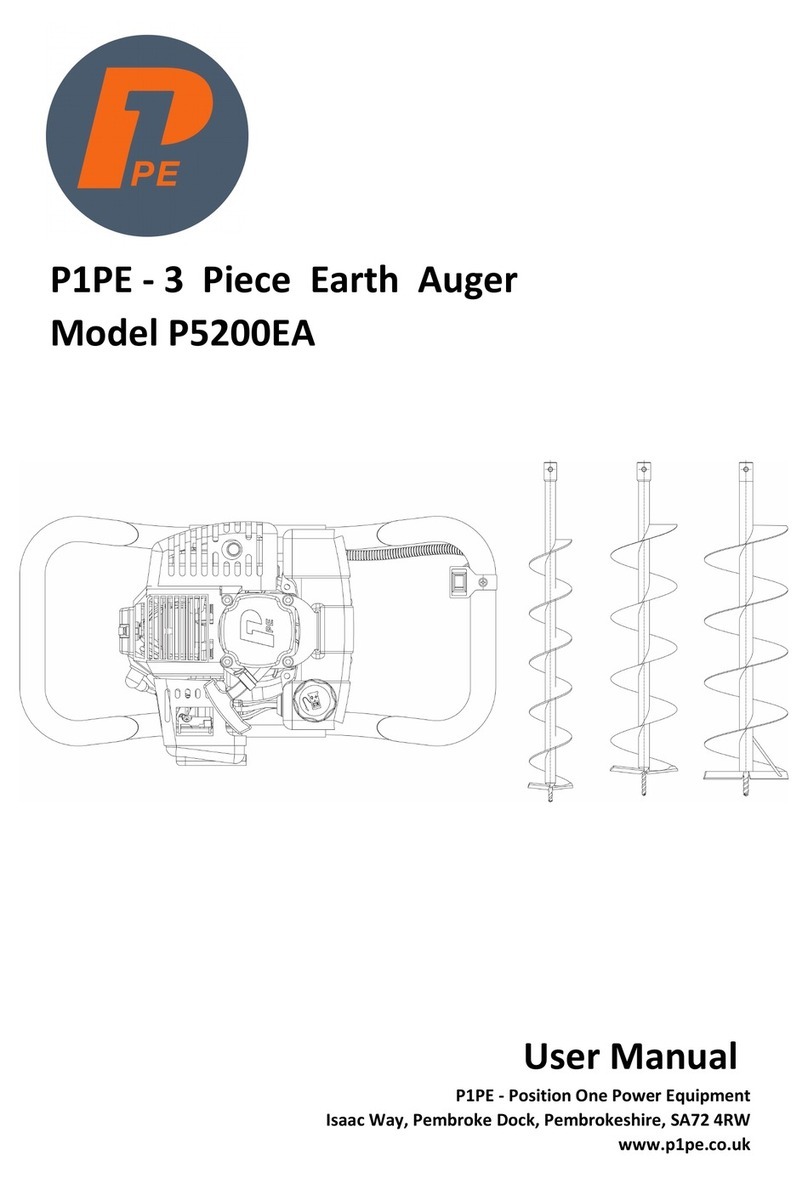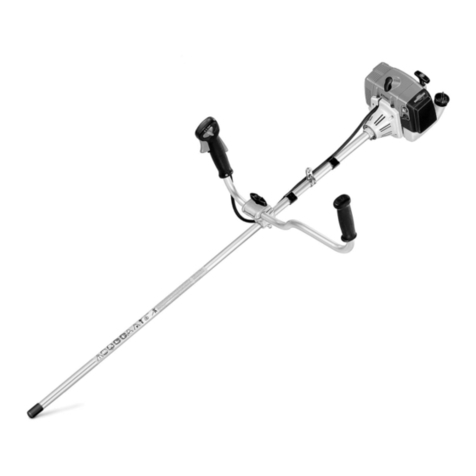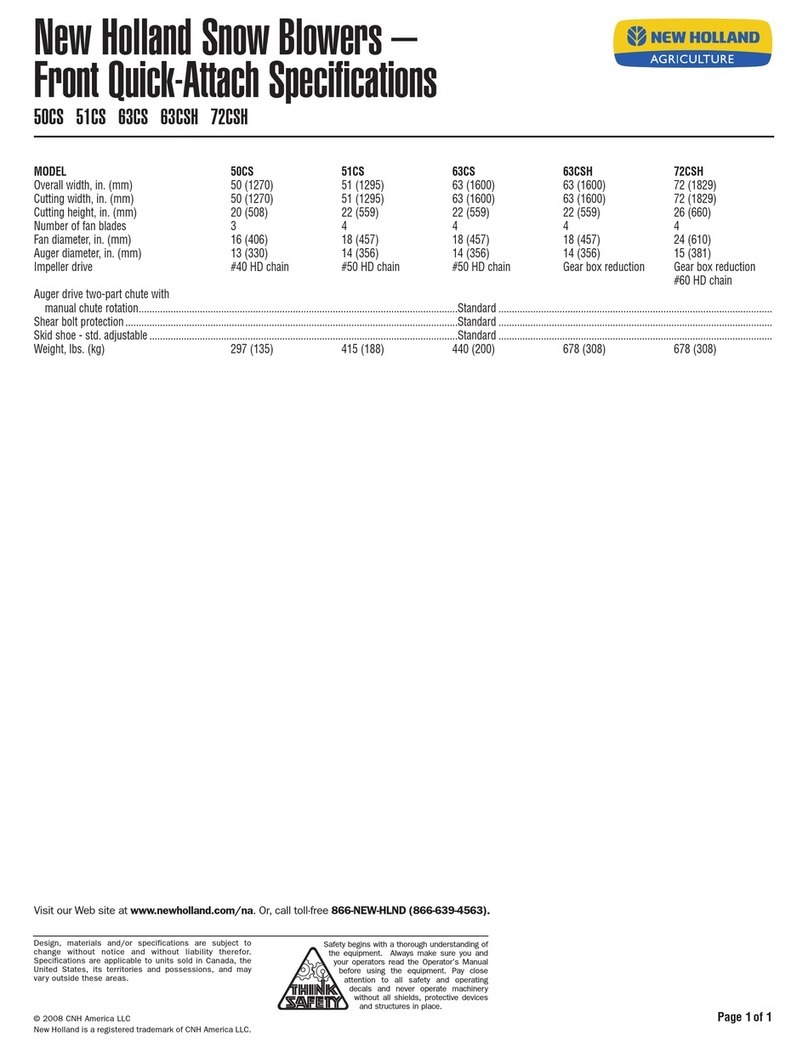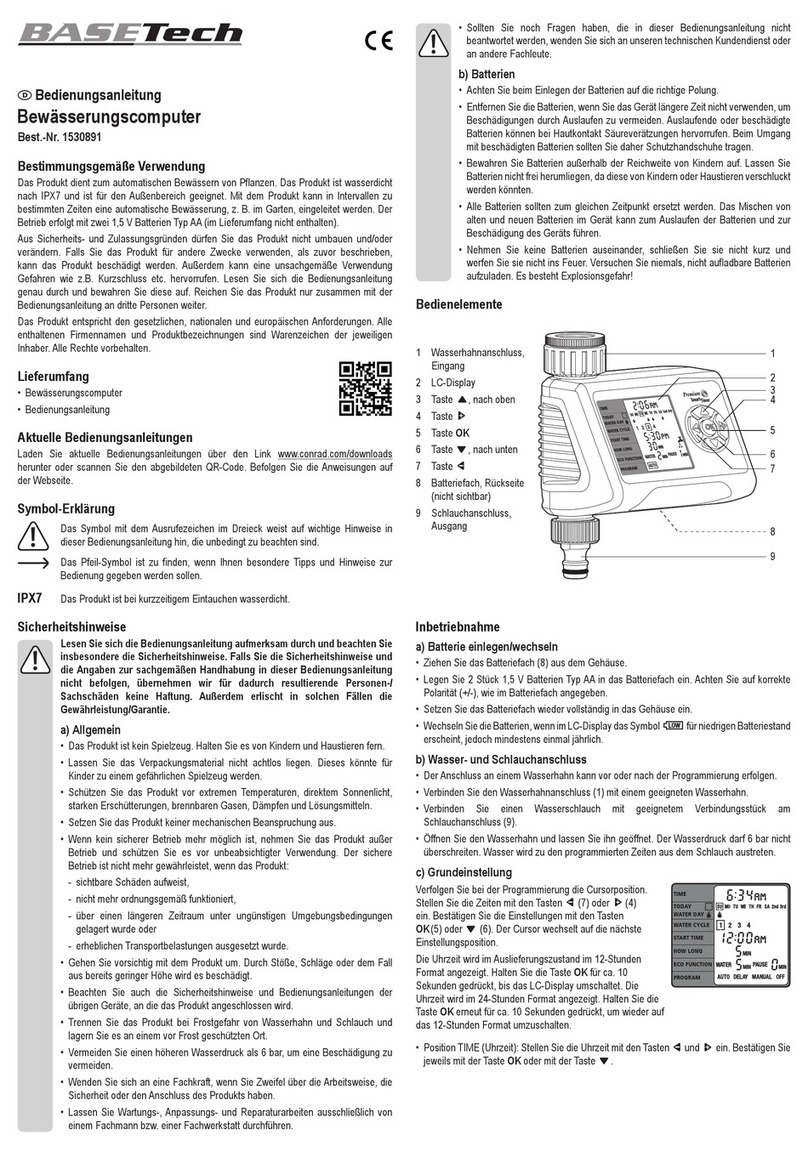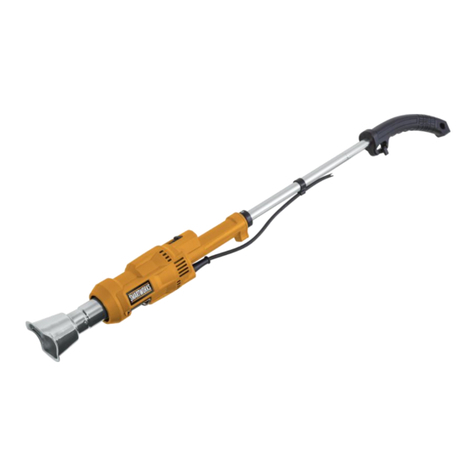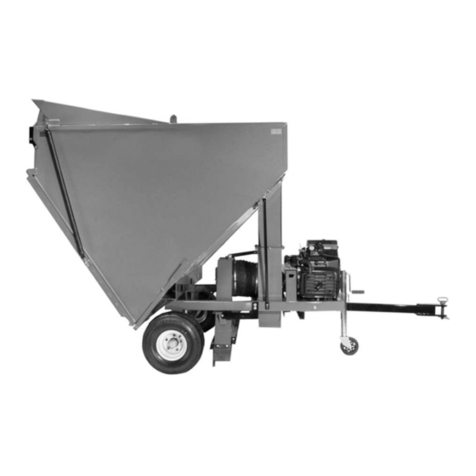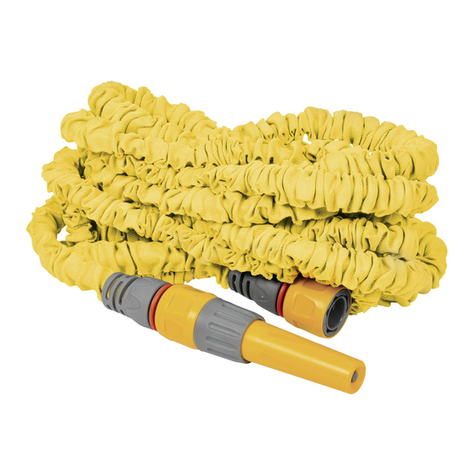Gearmore B SERIES Guide

ROTARY
TILLER
"B" SERIES
Operation, Service
& Parts Manual
June 2006
FORM: BTillerBook.QXD

No part of this manual shall be reproduced, copied or disseminated by any means, without
manufacturer prior authorization in writing.
manufacturer reserves the right to make any necessary changes without giving prior notice,
in order to optimize the quality and safety features and does not commit itself to updating
this manual every time a change is made.
This booklet provides a thorough and accurate description of the instruction and mainte-
nance activities to be carried out on the tiller you purchased. We congratulate you on your
choice and urge you to thoroughly familiarize yourself with and follow the instructions con-
tained in this manual. This will assure you a long, safe and trouble free working life for your
tiller.
The Manufacturer shall not assume any responsibility should problems arise as a
result of lack of compliance with the instructions and/or operator's negligence.
The manual is divided in chapters and paragraphs and the pages are numbered, thus offer-
ing accurate and precise information.
The requested information can be easily found by searching the key words or referring to
the index.
Date of Purchase: _______________________________
Model Number:_________________________________
Serial Number __________________________________

INDEX
GENERAL INFORMATION
Symbols . . . . . . . . . . . . . . . . . . . . . . . . . . . . . . . . .Page 1
Safety labels . . . . . . . . . . . . . . . . . . . . . . . . . . . . . .Page 2
Technical data . . . . . . . . . . . . . . . . . . . . . . . . . . . . .Page 3
Main parts terminology . . . . . . . . . . . . . . . . . . . . . . .Page 4
Identification plate . . . . . . . . . . . . . . . . . . . . . . . . . .Page 5
Recommended use . . . . . . . . . . . . . . . . . . . . . . . . . .Page 5
Inappropriate use . . . . . . . . . . . . . . . . . . . . . . . . . . .Page 5
Torque Specification . . . . . . . . . . . . . . . . . . . . . . . . .Page 5
SAFETY
Safety in the workplace . . . . . . . . . . . . . . . . . . . . . . .Page 6
User's requirements . . . . . . . . . . . . . . . . . . . . . . . . .Page 6
Work clothing . . . . . . . . . . . . . . . . . . . . . . . . . . . . . .Page 6
General safety norms . . . . . . . . . . . . . . . . . . . . . . . .Page 6
Preparation . . . . . . . . . . . . . . . . . . . . . . . . . . . . . . .Page 7
SET UP
Attachment to the tractor . . . . . . . . . . . . . . . . . . . . .Page 8
PTO shaft connection . . . . . . . . . . . . . . . . . . . . . . . .Page 9
Working depth adjustment . . . . . . . . . . . . . . . . . . . . .Page 9
Leveling board adjustment . . . . . . . . . . . . . . . . . . . .Page 10
Chain adjuster . . . . . . . . . . . . . . . . . . . . . . . . . . . .Page 10
Start up . . . . . . . . . . . . . . . . . . . . . . . . . . . . . . . . .Page 10
3-Point hitch assembly . . . . . . . . . . . . . . . . . . . . . .Page 11
MAINTENANCE
Road transport . . . . . . . . . . . . . . . . . . . . . . . . . . . .Page 12
Shut down . . . . . . . . . . . . . . . . . . . . . . . . . . . . . . .Page 12
First check . . . . . . . . . . . . . . . . . . . . . . . . . . . . . . .Page 12
Every 8 working hours . . . . . . . . . . . . . . . . . . . . . . .Page 12
Every 50 working hours . . . . . . . . . . . . . . . . . . . . . .Page 12
Every 500 working hours . . . . . . . . . . . . . . . . . . . . .Page 12
Blades replacement . . . . . . . . . . . . . . . . . . . . . . . . .Page 13
SPARE PARTS
How to order spare parts . . . . . . . . . . . . . . . . . . . . .Page 14
Tiller Parts Breakdown . . . . . . . . . . . . . . . . . . . . . . .Page 15
Tiller Parts List . . . . . . . . . . . . . . . . . . . . . . . . . . . .Page 16
Driveline Assembly . . . . . . . . . . . . . . . . . . . . . . . . .Page 19
Slip Clutch Assembly . . . . . . . . . . . . . . . . . . . . . . . .Page 20
Limited Warranty . . . . . . . . . . . . . . . . . . . . . . . . . .Page 21
TABLE OF CONTENTS

GENERAL INFORMATION
SYMBOLS
This booklet contains three "safety pictograms" which highlight the relevant danger
levels or important information:
It draws the operator's attention to special situations which
may jeopardize people's safety.
It draws the attention to situations which unfavorably affect
the machine efficiency, but not people's safety.
It is used for general information, when people's safety or
the efficiency of the parts are not at risk.
GENERAL INFORMATION
Page 1

SAFETY LABELS
The safety labels and information on the machine (picture 1, 2 and 3), must be
complied with. Failure to comply with these warnings may result in severe injuries
or even death. Make sure that the labels are always present and legible; should
this not be the case, contact your nearest Gearmore dealer to request replacements
SAFETY LABELS
Page 2
1
2
3

TECHNICAL DATA
Page 3
TECHNICAL DATA
Model Tilling Width HP
Weight
(Approx.) Working Depth
(Max) Side Drive Blades
(Qty)
Blades
cm Inches kg lbs cm Inches Chain Gear Blades/
/flange Shape
B
100 39 15-35 130 290 18 7 * 30 6 Curved
120 47 15-35 145 323 18 7 * 36 6 Curved
140 55 15-35 175 389 18 7 * 42 6 Curved
150 59 15-35 185 411 18 7 * 42 6 Curved

MAIN PARTS TERMINOLOGY
Page 4
MAIN PARTS TERMINOLOGY
A) Main Frame
B) Lower Hitch Brackets
C) Top Link Bracket
D) PTO Guard
E) Top Mast
F) Rotor
G) Tines
H) Skids
I) Transmission case
L) Rear Board
When asking for information or technical service,
always specify the machine type and width.

INFORMATION
Page 5
IDENTIFICATION PLATE
An identification plate is placed on each tiller and is structured as follows:
Serial number (sample):
RECOMMENDED USE
The tillers described in this instruction and maintenance manual, have been designed explic-
itly to till the land. Any other use jeopardizes the operator's safety and the machine integrity.
INAPPROPRIATE USE
The tillers shall not be used as follows:
eConnected to vehicles which do not have a suitable power or weight.
eWithout being properly installed by securing the hitch brackets to all three points
of the tractor lift unit.
eTilling of extremely stony or unsuitable ground.
eIn close proximity to person/s when power is engaged.
eDo not stand or step on the equipment when it is being operated or transported.
eDo not operate the machinery while wearing unsuitable (loose fitting) clothing.
TORQUE SPECIFICATIONS
For correct hardware tightening on the tiller, we suggest the use of suitable torque wrench
and the applicable torque as listed in the table below:
M-THREADED SCREW/BOLTS
Bolt grade
Thread 8.8 10.9
Nm Lb-ft Nm Lb-ft
M6 11 8.5 17 12
M8 28 20 40 30
M10 55 40 80 60
M12 95 70 140 105
M14 150 110 225 165
M16 240 175 305 225
M18 330 250 475 350

SAFETY
Page 6
SAFETY IN THE WORKPLACE
Most of the accidents, which occur while the operator is using the machine or the equipment
or carrying out maintenance and repair activities, are caused by the non-compliance with the
main safety requirements.
Therefore the potential risks must be fully understood and special attention must be paid to
the activity which is being executed.
If potentially dangerous situations are known,
accidents can be prevented!
USER'S REQUIREMENTS
The equipment user must have the following:
Physical: good sight, co-ordination and capability to execute all instructions in a safe manner.
Mental: the users must understand and follow the prescribed norms, rules and safety meas-
ures. They must be careful, pay attention to their own safety and the safety of other people
and act properly and in a responsible way.
Training: the users must read and understand this manual, its pictures and charts, and the
identification and hazard plates. They must be specialized, trained and qualified on any use
and maintenance activities.
WORK CLOTHING
The following clothing and personal protective equipment must be used when working and
executing maintenance and repair activities:
eOveralls or any other comfortable outfit; make sure that they
are not too loose since they might be caught by moving parts.
eProtective gloves.
eGoggles or mask to protect the eyes and face.
eSafety helmet.
eSafety shoes.
Make sure that the personal protective equipment is
properly stored and complies with the laws in force.
GENERAL SAFETY NORMS
The features of the area where work is taking place must always be taken into consideration:
eDo not stand in the working radius of the operating machinery or any other machine
accessories when the equipment is running.

PREPARATION
Page 7
Prepare the work:
eDo not drink alcohol, take drugs, or any other substances which may affect the your
ability to use the equipment before or when working.
eMake sure that there is sufficient fuel in the tractor to prevent the machine from
stopping during work.
eDo not use the equipment under unsafe conditions, e.g. do not make temporary repairs
just to start or keep working; do not work at night if the area is not well illuminated.
When working or executing maintenance activities, remember:
eThe labels and stickers providing instructions on the use of the equipment or
information on dangers must not be removed or hidden, and must be legible.
eDo not remove the safety devices, covers and safety guards, unless maintenance
activities are being carried out. If the safety devices must be removed, turn the engine
off, remove them correctly and re-install them before turning the tractor on.
eDo not lubricate, clean or adjust moving parts.
eUse the appropriate tools to execute maintenance or adjustment activities on the
equipment.
eDo not use damaged or unsuitable tools, e.g. pliers rather than wrenches etc.
ePrior to carrying out activities on hydraulic lines under pressure, or disconnecting their
components, make sure that the line is no longer under pressure and that it does not
contain any hot fluids.
eCheck all the fittings and make sure that they are well connected before supplying
pressure to the hydraulic lines.
eMake sure that no tools, clothes or any other materials are left in areas where moving
parts are present when the maintenance and repair activities are completed.
eDo not give directions and make signals at the same time during a maneuver.
Maneuver directions and signals must be given from one person only.
eDo not unexpectedly call an operator, if not necessary. Do not startle the operator, e.g.
by throwing objects.
ePay attention to people in the vicinity of the work area, especially children!
eMake sure that nobody is standing in the working range of the equipment.
eDo not use the equipment to lift people.
eWhen the equipment is not needed, turn the engine off, leave the vehicle on a flat sur
face, with the first gear and the parking brake engaged. Disengage the power take off.
eDo not execute any cleaning, lubrication, repair or adjustments when the engine is
running and the equipment is in the raised position.
eDo not work on steep slopes, if the stability of the vehicle can be jeopardized.
Manufacturer shall not assume any responsibilities if these instructions are not strictly followed.

SET-UP
Page 8
ATTACHMENT TO THE TRACTOR
Carefully read this instruction manual and the manuals of the tractor and PTO shaft manufac-
turer. All tillers are built to be attached to any tractor equipped with a three point hitch of the
correct category and with suitable ball ends.
Before attaching the equipment to the tractor, make sure that the ground is smooth and flat and
that nobody is standing between the tractor and the tiller; slowly move the tractor towards the
tiller by aligning the tractor lower lift arms with the two tiller coupling side pins; turn the engine
off and pull the brake.
It is possible to adjust the attachment position
releasing the bolts B. (picture 1) and modifying
the position of the plates A. Tighten the bolts
after making any adjustment.
picture 1
After adjusting the couplers, connect the lower lift arms by removing the lynch pins from the
pins located on the hitch brackets, inserting the lift arm pins through the hitch block and ball
ends and secure them by means of the pins which were previously removed.
Connect the tractor top link to the top mast by
removing the pin located between the two plates,
inserting the top link and securing it by means of
the pin.
Adjust the top link so that the upper part of the
frame is parallel to the ground.
Block all the linking parts by means of the sway
chains or arms.
Make sure that the central unit axis (gearbox
assembly) is parallel to the ground, thus minimiz-
ing the stresses on the power take off and increas-
ing the working life of the equipment.
picture 2
After executing all the above-mentioned activities,
make sure that all the nuts and bolts are tightened.

Page 9
SET-UP
PTO SHAFT CONNECTION
Before installing the PTO shaft make sure that the RPM rating and the direction of rotation
match those of the tractor. Carefully read the PTO shaft and tractor instructions.
Furthermore, accurately read the instructions of the manufacturer of the PTO shaft and of the
tractor.
Before starting any activity, make sure that the guards are installed on the power take off of
the tractor and PTO shaft. Make sure that they cover the PTO shaft throughout its length.
When fully extended, the plastic pipes must overlap by at
least 1/3 of the length of the pipes (LT). When retracted,
the min. acceptable clearance is 2 inches (picture 3).
picture 3
Check that the PTO shaft min. and max. length
are within the parameters of the machine-
tractor coupling.
Should problems arise, contact your dealer.
After the installation, anchor the PTO shield to
the tractor and machine using the special
chains; make sure that it turns smoothly. If
the PTO shaft is equipped with safety devices,
e.g. torque limiters or free-wheel devices,
install them on the operative machine side.
For the use and maintenance of the PTO shaft,
please refer to the relevant manual.
WORKING DEPTH ADJUSTMENT
The working depth of the equipment depends on the position of the lateral skids.
If the skids are raised, the working depth increases; if the skids are lowered, the working
depth decreases.
Make sure that the skids are set at the same height on both sides.
picture 4
To adjust the working depth, loosen and remove
nut A(picture 4) and adjust the skid height
according to the holes B. When the adjustment
is completed, tighten the screws.

SET-UP
Page 10
picture 5
LEVELING BOARD ADJUSTMENT
The height of the rear leveling board can be
adjusted, making the ground more compact
and smooth. Release the chain A from the
bracket B (picture 5), and re-engage it
according to the desired working height.
These activities must be carried out with the engine off,
the power take off disengaged and the hand brake
applied. If needed, lift the equipment and place it on sup-
ports, thus preventing any injuries that might be caused
by a sudden fall of the equipment.
CHAIN ADJUSTER
The B tillers are equipped with a self-loading chain drive system (picture 6).
The setting of the system is made during assembly; any adjustments when using the
machines, must be carried out by an authorized dealer or work shop.
picture 6
START UP
After carrying out these adjustments, the equipment is ready for use. When at the working
area, do not start the power take off with the tiller in working position in the ground. Be
sure to lift it by a few centimeters using the tractor lift. Start the engine, engage the power
take off, lower the equipment to its working position and start.

Page 11
SET-UP
ASSEMBLING B SERIES 3-POINT HITCH
STEP 1: Install the top mast to the tiller main frame as shown.
STEP 2: Install the top link bracket to the top mast with the hole in the highest position
as shown.
STEP 3: Install the bottom link brackets with the holes facing down. This gives you
the standard A.S.A.E. dimension of 18" if the tractor does not have a quick
hitch.
STEP 4: If the tractor has an A.S.A.E. quick hitch, place the bottom brackets with
the holes in the high positions to obtain the correct spacing to tractors with
quick hitches.
NOTE: It is necessary to order a 3 bushing kit - part number 883303 - to
make the tiller A.S.A.E. quick hitch compatible.

MAINTENANCE
Page 12
ROAD TRANSPORT
With reference to road transport, follow local traffic regulations.
SHUT DOWN
The following activities are recommended if the tiller will not be used for a long period of time:
1 Clean and dry the equipment.
2 Inspect the equipment and replace the damaged or worn parts if necessary.
3 Tighten all the screws and nuts.
Lubricate and cover the machine with a tarpaulin and store it in a dry place.
MAINTENANCE
Maintenance is crucial for the working life and efficiency of any agricultural equipment. If the
equipment is properly maintained and operated, a long working life and operator safety are
assured.
The maintenance intervals indicated in this booklet are provided as a mere reference and are
related to normal working conditions; changes may occur depending on the type of activities,
environmental dust, seasonal factors, etc.
eBefore injecting lubricating grease into the grease fittings,
clean the fittings to prevent mud, dust, or any other
foreign matter from contaminating the grease and reducing
the lubrication effect.
eWhen adding or changing the oil, use the same type of oil
to prevent mixing oils with different features.
eAll maintenance activities must be carried out with the tiller
resting horizontally on the ground.
eAfter using the equipment for a few hours, make sure that
all the bolts (especially tine bolts) are tightened; regularly
check all the machine guards.
FIRST CHECK
eAfter 50 working hours, change the oil in the gearbox and make sure that all the
screws and bolts are tightened.
EVERY 8 WORKING HOURS
eGrease the PTO shaft crosses.
EVERY 50 WORKING HOURS
eRemove the cover (A - pict. 7, pg. 13) and grease the rotor bearing inside.
eCheck the oil level in the case/bevel gear pair (A- pict. 8, pg. 13) by removing
gearbox's upper oil plug (A- pict. 8, pg. 13); oil level should be contained between
the 2 nicks of MIN & MAX of the dip stick oil plug (B- pict. 8, pg. 13). If needed add
SAE EP 80W90 oil.
eCheck the oil level in the side transmission (A- pict. 9, pg. 13). If needed add
SAE EP 80W90 oil.
eMake sure that all the screws and bolts, especially on the blades, are tightened.
EVERY 500 WORKING HOURS
eChange the oil of the case/bevel gear pair, side transmission and rotor support; use
SAE EP 80W90 oil. Contact the closest dealer for this maintenance activity.

Page 13
MAINTENANCE
The old oil must be disposed of in compliance with the local
laws where these activities are carried out; do not spill or
dispose of waste oil on the ground.
The maintenance activities must be carried out with the
engine off, the power take off disengaged, the parking brake
engaged, and the equipment placed on the ground.
BLADES REPLACEMENT
To assure the optimum efficiency of the machine, make sure that the tiller blades are in a
good working condition and that their bolts are tightened; replace them if they are broken
or bent. The new parts must be installed in the original position.
picture 7 picture 8
picture 9
Normal Spring Tension of Slip Clutch

SPARE PARTS
Page 14
Before replacing the blades, turn the tractor engine off, pull
the parking brake, disengage the power take off, raise the
tiller using the tractor lift, and install supports to prevent
accidental dropping of the machine.
picture 10 picture 11
HOW TO ORDER SPARE PARTS
For spare parts requests please refer to our spare parts catalogue.
The spare parts can be ordered from the dealer or service center. The following data must
always be specified:
eEquipment model and width.
ePart number of the requested component. If the code number is missing, indicate the
reference number in which it is shown and the relevant reference.
eDescription of the part and requested quantity.
eRequested type of transport. Should this information not be provided, the dealer or
service center shall not be responsible for delays caused by circumstances beyond
their control. The addressee shall be responsible for any transport charges.
Pay special attention to the bolts Aon the blades (picture 10): the screw head must be placed
on the blade side, with the washer and the nut on the flange side, so that the bolts cannot
loosen while the equipment is being used.
When several blades must be replaced, replace one blade at a time, so that the initial helical
layout is maintained (picture 11).

Page 15
"B" TILLER ASSEMBLY

TILLER ASSEMBLY
Page 16
REF# QTY. PART NO. DESCRIPTION
1 1 4001330 Top Mast
2 24 31512030 Bolt UNI 5739 M12 x 30 8.8
3 18 34100012 Nut UNI 5587 M12
4 22 34121012 Washer UNI 1751 M12
5 1 4301589 Pin, Top Hitch (Cat. 1)
6 3 6351004 Cotter Pin
7 2 6320035 Circlip External
8 1 4701359 Gear Z11
9 1 6307-2RS Bearing
10 1 4211203 Shaft B100
10 1 4211205 Shaft B120
10 1 4211207 Shaft B140
10 1 4211208 Shaft B150
11 2 4781265 Gasket
12 1 4001282 Shaft Support B100
12 1 4001284 Shaft Support B120
12 1 4001286 Shaft Support B140
12 1 4001287 Shaft Support B150
13 4 31510020 Bolt UNI 5739 M10 x 20 8.8
14 29 34121010 Washer UNI 1751 M10
15 13 31510025 Bolt UNI 5739 M10 x 25 8.8
16 1 4001331 Top Hitch Clevis
17 1 6307 Bearing
18 1 17265-01 Bevel Gear Z19
19 1 6320030 Circlip External DIN471
20 1 E8223400 Driveline AX4 500/748
21 1 30305 Bearing
22 1 6470116 Gasket M16
23 1 6481600 Drain Plug M16
24 1 35X62X10 Oil Seal
25 1 6007 Bearing
26 1 17265-00 Bevel Pinion Z13
27 1 4211212 Input Shaft Z6
28 1 16565-00 Gearbox Housing
29 1 65316-05 Plug with Level M16
30 4 31512025 Bolt UNI 5739 M12 x 25 8.8
31 2 4301590 Pin, Lower Hitch
32 1 4931230 Gearbox Plate Support
33 2 6310062 Internal Circlip D562 DIN 472
34 1 4001234 Parking Stand Leg
35 1 6100062 Cap 062

REF# QTY. PART NO. DESCRIPTION
36 2 4001278 Lower Hitch Clevis
37 1 4236115 Pin
38 3 4201202 "U" Bolt
39 1 4011237 Rotor B100
39 1 4011239 Rotor B120
39 1 4011241 Rotor B140
39 1 4011242 Rotor B150
40 1 4001303 Frame B100
40 1 4001305 Frame B120
40 1 4001307 Frame B140
40 1 4001308 Frame B150
41 16 34100008 Nut UNI 5587 M8
42 1 34106008 Stop Nut M8 x 1.25 DIN 982 6S
43 1 4002338 Rod B100
43 1 4002340 Rod B120
43 1 4002342 Rod B140
43 1 4002343 Rod B150
44 17 31508020 Bolt UNI 5739 M8 x 20 8.8
45 2 31512035 Bolt UNI 5739 M12 x 35 8.8
46 2 4831202 Skid Support
47 1 4001223 Leveling Board B100
47 1 4001225 Leveling Board B120
47 1 4001227 Leveling Board B140
47 1 4001228 Leveling Board B150
48 1 4508702 Chain
49 21 34100010 Nut UNI 5587 M10
50 2 6310090 Internal Circlip DIN 472
51 1 6320040 Circlip External DIN 471
52 1 4141242 Bearing Cover
53 12 31510030 Bolt UNI 5739 M10 x 30 8.8
54 1 6470118 Gasket
55 2 6308 Bearing
56 2 55X72X10 Oil Seal
57 2 4701202 Rotor Support
58 1 4701203 Hub, Idler Side
59 16 34121008 Washer UNI 1751 M8
60 3 4788744 Gasket
61 As Req'd 4811285 Tine, R.H.
62 As Req'd 4811286 Tine, L.H.
63 As Req'd 31412035 Bolt UNI 5738 M12 x 35 8.8
64 As Req'd 34101012 Nut UNI 5587 M12
TILLER ASSEMBLY
Page 17
Table of contents
Other Gearmore Lawn And Garden Equipment manuals
